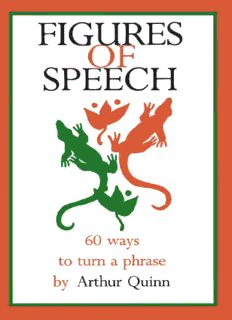
Figures of Speech : 60 Ways To Turn A Phrase PDF
Preview Figures of Speech : 60 Ways To Turn A Phrase
Figures of Speech FIGURES OF SPEECH 60 ways to turn a phrase by Arthur Quinn I ~ ~~o~;~~n~~~up NNeeww YYoorrkk LLoonnddoonn First Published by Gibbs Smith Publisher, Layton, Utah Reprinted 2010 by Routledge Routledge Taylor & Francis Group 711 Third Avenue New York, NY 10017 Routledge Taylor & Francis Group 2 Park Square Milton Park, Abingdon Oxon OX14 4RN Copyright © Arthur Quinn 1982 All rights reserved for all countries, including the right of translation. No part of this book may be used or reproduced without written permission of the publisher. ISBN 978-1-880393-02-4 And I must borrow every changing shape to find expression. T.S. ELIOT Contents Preface To And or Not to And 5 Effective Misspelling 19 Missing Links and Headless Horsemen 27 Man Bites Dog 39 Reds in the Red 49 More Than Enough 61 There There 73 Repetition Again 83 Conclusion 97 Abbreviations 100 Glossary/Index 101 Preface le AN STILL REMEMBER the occasion that started me thinking about writing this book. After having attended a stuffy academic convention, I impulsively decided to swing throughNewYork tospend theeveningwithafriendwhowas thenawriterfor aweeklynewsmagazine. Ineededsomefresh aIr. I met him at hisofficeon a Fridayevening,the night the magazine isput to bed. Fortunately, bythe time I arrived he had already finished his story for the week. Nonetheless, we had to wait for a while because hisstorywas beingsubmitted tothevariousreporterswhohadsupplied himtheinformation and had the right to suggestchanges. As he was scurrying in and out between phone conver sations with them, he tossed a copy of his story to me, and announced"ThereisonlyonesentenceIwon'tchange."Itwas obviously a challenge from the journalist to the professor. When hereturnedafewminutes later, Iread himthesentence. Hewaspleased; I'd gottenitright. "I thought thezeugma was particularly handsome," I said. Immediately his eyesglazed overand hereached for hiscoat. Itwasonlyafewhourslater, aftera pleasant dinner, that hefinallyasked, "All right, what the hellisa zeugma?" What the hellisa zeugma? It isjusta figure ofspeech, a rather witty one that I had never had the nerve to try. My friend hadtried onejust thatday;and heknewhehadwrittena nice sentence. What I knew was a name and definition that might help him isolate what was particularly striking about that sentence. This could beuseful because sooneror later he 2 Preface. FIGURES OF SPEECH would find himself in a position where he might want to try another one. And, infact, Icould supply him with a seriesof famous zeugmas, from Shakespeare, the Bible, Alexander Pope. I wouldn't have to comment on these examples; he could seefor himself the range of uses. In one sense he already had a greater command of zeugmas thanIdid, forhehad madeone-Iwaslearningfrom him. Zeugmas and the rest of the stylistic bestiary are of significance only insofar as they help us learn to write better. The professor learns from the journalist, and they both learn from Shakespeare.Thefiguresare not essential inthisprocess, but they can facilitate it. Usually they do nothing of the kind. Usually they are hoarded as the arcane argot of the professional humanist. Graduatestudentsinliteratureeagerlybuylittledictionariesso that when a monograph intones about later Shakespeare's penchant for the anthimeria, they willhave a place to look it up. So they look it up, while their own prose often becomes more and more likeamonograph's,agroaningmiserytoread. Writing is not like chemical engineering. We shouldn't learnthe figures ofspeech the waywelearn the periodictable of elements. We shouldn't because weare learning not about hypothetical structures in things, butabout real potentialities within our language, within ourselves. Learning about the figures of speech should belesslike learningabouttheperiodictable ofelements thanlikelearning how to model clay. To ask a sentence ifithas a zeugma isnot like asking a rock if it has silicon. In fact, the very phrase "figures of speech" is misleading in its static, passive form. It should b e the "figurings of speech"-or, better yet, simply "figuring speech." The figurings of speech reveal to us the apparently limitless plasticity of language itself. We are confronted, inescapably,withthe intoxicatingpossibilitythatwecanmake language do for us almost anything we want. Or at least a Shakespearecan. The figures ofspeech help usto seehow he does it, and how wemight. ~u 3 Therefore, in what follows, the quotations from Shake speare, the Bible, and other sources are not presented to exemplify the definitions; the definitionsare presented to lead tothequotations. And thequotationsarethereto showushow to do with languagewhat wehave notdone before. They are there-must I confess?-for imitation. I To And or Not to And ON THE NIGHT of June 21, 1932,Joe Jacobs, a pro fessional prizefight manager, after hearingthat hisman had not been awarded the decision, achieved for himself linguistic immortality by shouting into the ring announcer's microphone, "We was robbed!" "We"does not ordinarly go with "was."And we might thinkthatJacobshadsimplymadeagrammaticalmistake ofa rather rudimentary kind. Yet, ifhe had said "were," he likely would have been consigned to the same oblivion as was the smug winning manager. Farfrom beinga mistake, "was"was an inspiration.Itwas,to bemore precise,anenallage,whichis just the rhetorical name foran effectivegrammatical mistake. There are literally hundreds of such names that have accumulatedoverthecenturies, asgenerationaftergeneration has striven to gain and give mastery over language. These figures ofspeech have been named and collected becausethey are, if used properly, extremely helpful in learning and teaching how to write, speak, read, listen, better. Writingisa matterofmakinglinguisticchoices,and readingdepends upon understanding the linguistic choices made by someone else. The figures of speech help you see the choices available in a given context. And being able to see them helps you make them orjudge them. "We was robbed!" isa wonderfully effectivecomplaint. Asreadersand writers,wewould liketounderstandbetterwhy it isso effective. Not from a theoretical point of view.(Style, someone said, islike a frog; you can dissect the thing, but it somehowdiesintheprocess.) Ratherwewanttounderstandit 5
Description: